Rick, the raft, & the rig
By coincidence, two days before the day of the month on which my father was born, on 8 January 2025, my cousin Dawn Morrow called to tell us my cousin, Richard “Rick” Morrow died suddenly that day. I was and am sad, taken aback by this completely unanticipated event. Four+ months later, I am called to ‘pen’ this tribute to Rick and my memories of him, our times together, most especially our boyhood days. My sense, in part is that my grief is two-fold: one in major part for Rick and his death at almost 75 years of age (we were born 9 months apart…Rick the younger); and two, for the ‘death’ of my and our youth symbolized, for me, in Rick’s passing. For me, it is as though there is a profound uncoupling of our first cousin connection, a substrate disconnected now from its enzyme. And it is that loss and the flood of evanescent boyhood memories that I wish to explore in this blog. Mostly, I want to ruminate about our time together; what that time meant to me; the kinds of things we enjoyed in our youth; and some context about my boyhood memories with 2 other first cousins from my mother’s side of the family. There is a Peter Pan-ness to my memories and our adventures not in Neverland, not in clinging to perpetual youth, but in the Ever Land of my shared experiences.
Growing up, I knew Rick as Rick. At some point in his life, he decided he preferred to be called Richard. He wasn’t adamant about it and seemed to go by both names – I always called him Rick – and I never bothered to ask him the reason/s for the naming duality. I do remember his dad and his mom, Roy (my father’s older brother) and Betty calling him Richard quite frequently when he was young. In our infrequent communications in person or by phone, Rick often called me Donald, again, for reasons I know not. I make up now that there was a kingliness to his Richard-choice, like, not by any intention of his, the British monarch, King Richard I, the Lionheart, the latter of the 12th century Crusades’ fame. Richard/Rick had his domain and a multiplicity of ‘crusades’ so fittingly captured in the picture posted with his obituary:
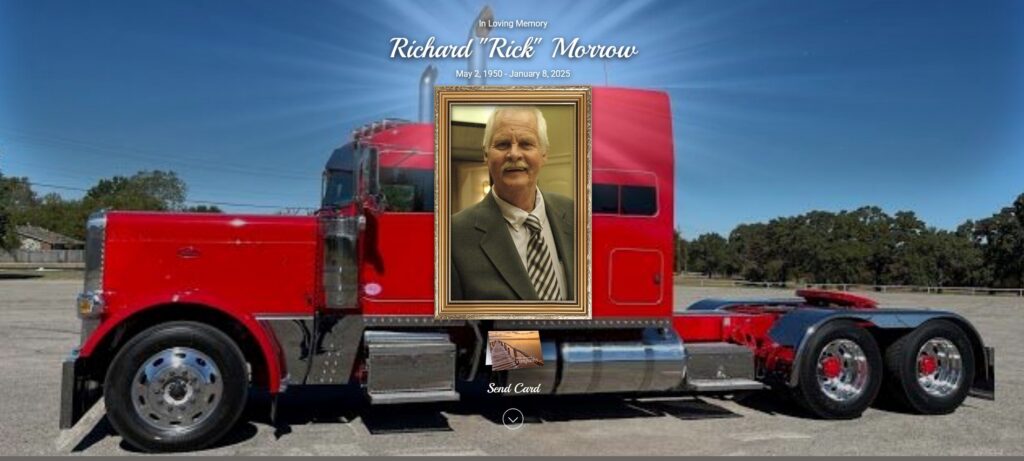
Rick was a professional driver for most of his working life. Very early in his adult years, he sold men’s clothing at a local store in Simcoe where he lived his entire life. The photo above is not, I am told, his ‘rig’ but his image superimposed on the symbolic truck-cab is a perfect tribute to a job and lifestyle he absolutely loved. The wryness of his smile and his deep-set eyes draw me into his visage now. His actual obituary, fittingly, is elegantly and eloquently simple and I want to cite it here for my memory as time passes – note how the red cab is watermarked in the photo of the obituary:
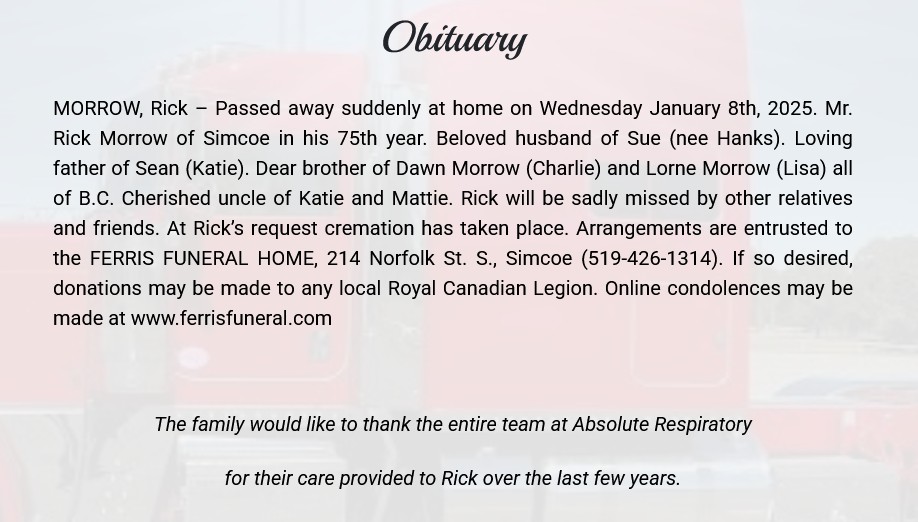
Until my cousin, Rick’s sister, Dawn called me to inform me about Rick’s passing, I did not know he had been ailing for the last few years. The gratitude expressed to Absolute Respiratory care in his obit suggests to me that Rick gradually succumbed to his life-long habit of smoking – he was a heavy smoker. Recently, I found out that Rick suffered from contracting Covid, at least twice, the second time while in hospital at Norfolk General (possibly in January 2023). From my reading of research re Covid, I wonder if his already weakened respiratory system was a prime target for that insidious virus. His smoking lifestyle choice was a huge barrier in terms of he and I maintaining any kind of in-person connection in our adult lives. He smoked everywhere and the smell of smoke, first- and second-hand was just too strong for me to tolerate for any length of time. Occasionally, when passing through London to or from a truck delivery, he would stop in to visit. We asked him to smoke outside and he obliged for the most part, although there were several times, we noticed the cigarette odor in our bathroom even though it was obvious he had tried to mask his covert behaviour by leaving the bathroom window open. Likely the easiest connection we experienced was Rick’s invitation to go on an open-deck boat trip and dining excursion out of Port Dover at some point in our mid-adult lives. I don’t remember much about the event but it did allow Rick to smoke and all of us to enjoy a meal together.
Aside from smoking, we respected each other’s lifestyle although world’s apart in our ability to really ‘get’ what each other did professionally. Rick dropped out of high school after grade 10 and never did complete his formal education, to the best of my knowledge. And I’m told Rick had to deal with dyslexia (and possibly being on the ADHD spectrum) most of his life; I don’t think either of those would have been diagnosed in the 1950s/1960s and I doubt he received much, if any, assistance or accommodation if he did suffer from either one of those issues. My job as a university professor was very likely an enigma to him. For me, I absolutely would have loved to accompany him on a ‘haul’ or ride-along in his truck and we often talked about it with me adamant that I would not be able to be in the cab when he smoked. We came close once or twice actually to schedule a trip together only to have the plan aborted when Rick admitted he would not be able to refrain from smoking while driving. A couple of times, while visiting him at his home in (266) John Street, Simcoe, the yellow-siding house below,

I did get to sit in the inside of his cab or tractor (no trailer attached), deep blue in hue, as I recall. It seemed cavernous, so much space. There was a bunk area behind the two seats, the bed twin-sized and a mini-fridge and microwave, I think – perhaps even a small television if appointed like other cab-bunk trucks. I know that at different points in his career, he rented his cab, or, bought one, or, drove company trucks.A couple of times, he drove me a few blocks and his driving adeptness was so apparent. I often thought – still do – what it would be like to drive an 18-wheeler? He drove local, regional, and long-haul routes throughout his career. I think of the constant manual gear-shifting, up-shifting and down-shifting; the two sets of air brakes, one for the tractor, one for the trailer. Backing up a semi truck to load/unload would be such a skill. Similarly, it must have been an art just hooking up a trailer to the 5th wheel or the plate above the tractor’s back wheels where a semi trailer’s kingpin hooks to the tractor:

Truckers taking corners in small spaces is always marvelous for me to watch. What was it like for Rick to long-haul, be away from home for weeks at a time? I conjure all kinds of elements that would be second-nature to him: truck stops and best food places; traffic jams; weigh scales’ obligatory stops; open highways, advertising, and mileage signs; magnificent scenery all over Canada and the US; waiting to load or off-load cargo; interminable lifting or hand-bombing smaller loads (Rick had back aches at different points in his career); the camaraderie of his fellow truckers (though an introvert in many ways, Rick loved to talk to people); engine maintenance and breakdowns; refueling the truck’s huge dual tanks with diesel fuel – greater efficiency and power; the potential danger of someone trying to break into and rob from his truck (he kept a crowbar, I think he told me, for self-defense); perpetual vibrations from the tractor’s powerful engine; blazing sunshine and bad weather (snow chains for mountain passes?).
To the best of my knowledge, Rick had a flawless truck-driving record – no accidents while driving millions of miles during his professional career! I know Rick was an inveterate reader of novels – Louis L’Amour most especially and likely others of that ilk – Cormac McCarthy and perhaps Elmer Kelton. From some of his Facebook postings, he might have enjoyed the Harry Potter series too. I suspect he read a lot in his bunk when parked for the night or when waiting for loading/unloading. While driving, did he listen to music to pass the time – country western was his genre I believe – talk on the phone? I am told that a lot of truck drivers still use CB (Citizens Band) radios for communication among drivers re traffic and road conditions, weather information, and as a supplement device in areas with limited cell service. Did Rick retain one and if so, did he have a CB ‘handle’? As with any profession, I suppose, there are so many components to a professional truck driver’s world…and it was Rick’s realm, his perpetual ‘crusades’ in his driving kingdom and from every conversation I ever had with him, he loved his job. I distinctly remember around the age of 10 or 12, Rick speaking in admiration and awe of his Uncle Lorne who drove a dump truck (I believe) and Rick opining with conviction that he too would be a truck driver some day.
In our teens, we each owned motorcycles. Foreshadowing, possibly, his driving prowess and my more engine-timid nature, Rick drove a Triumph bike at the time (late 1960s), one that was much, much larger in size and power than my Yamaha 80cc belt-drive motorcycle. I know that in his later years, Rick owned a touring Harley-Davidson, one of the largest bikes on the road. He seemed both comfortable with and adept at driving his motorcycles. From his Facebook posts over the past few years, it is crystal clear that Rick revered farmers, truckers, veterans, and the monarchy, especially Queen Elizabeth II. And we shared a mutual affection of/for anything connected to A.A. Milne’s Winnie the Pooh, but especially the lovable Pooh cartoons expressing warm human values. Equally clear was Rick’s social media-expressed disdain for Prime Minister Justin Trudeau and Rick’s firm conviction that global warming and greenhouse gas issues were not real.
I feel like I knew pieces, fragments really of Rick as an adult. He adored his wife, Sue and interestingly, their only child, Sean and my youngest son Wes were about the same age and both when around 9 or 10, sported a rattail hairstyle, one characterized by a long tail-like element of hair about 6 or 7 inches in length growing downward from the back of the head along the neck, . It was an 80s, early 90s style of hair and to the best of my knowledge, neither Wes or Sean knew each other or ever even met. Rick and Sue lived at their John Street home for decades. And I remember their earliest home was a house trailer situated in a trailer park located centrally in Simcoe just off of Highway 3, the main east-west corridor in the town. What part of life – our lives – I treasure and shared with Rick was our boyhood and the richness of those salad days of our youth.
I believe the first home where Rick lived in the 1950s was at 108 Owen Street, a duplex (I think) located about 3/4 of a kilometer from his 266 John Street adult home. My father and Rick’s were very close brothers and we spent a lot of time visiting Roy and Betty and their family in Simcoe. I can remember going to the Owen Street house but only vaguely. For some reason, I image an oil burning heater somewhere in its front room but no other home structures remain. What I do vividly recollect is Rick and I mixing ‘magic’ super-power concoctions in mini coke bottles like this one
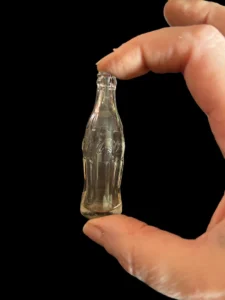
Where we acquired these 2+-inch bottles I do not know. Inspired perhaps by Dell Superman comics and our fertile imaginations, Rick and I would mix cinnamon and any other powders we could find in the kitchen in water then fill the mini containers. We’d take the bottled, obviously potent potions outside, drink them, and then run obviously at super speed along Owen and adjacent streets. Sadly, my most enduring memory of the Owen street house was me at 8 years of age bolting from the house in tears and anger and sorrow refusing to go to my mother’s funeral in 1957. I had been at the funeral home earlier and asked my Dad if I could touch my mom (clad in a blue dress, her neck adorned with a pearl necklace) in the open coffin. No one told me she would be cold and when I touched the frigid skin of her hand, I must have recoiled, gasped for air, and for years could not abide the smell of flowers indoors, likely from the inhaled floral scent Pavlovian paired with my gasped-terror in that funeral parlour. It may well be that I bolted from the funeral home and that seems more likely. Nevertheless, I simply could not attend her funeral and assume now that someone from the Owen Street house must have stayed with me during the actual funeral.
The house in Simcoe I do remember with so many cherished early youth memories was Rick’s home at 881 Norfolk St North. This is the current street view of that address:
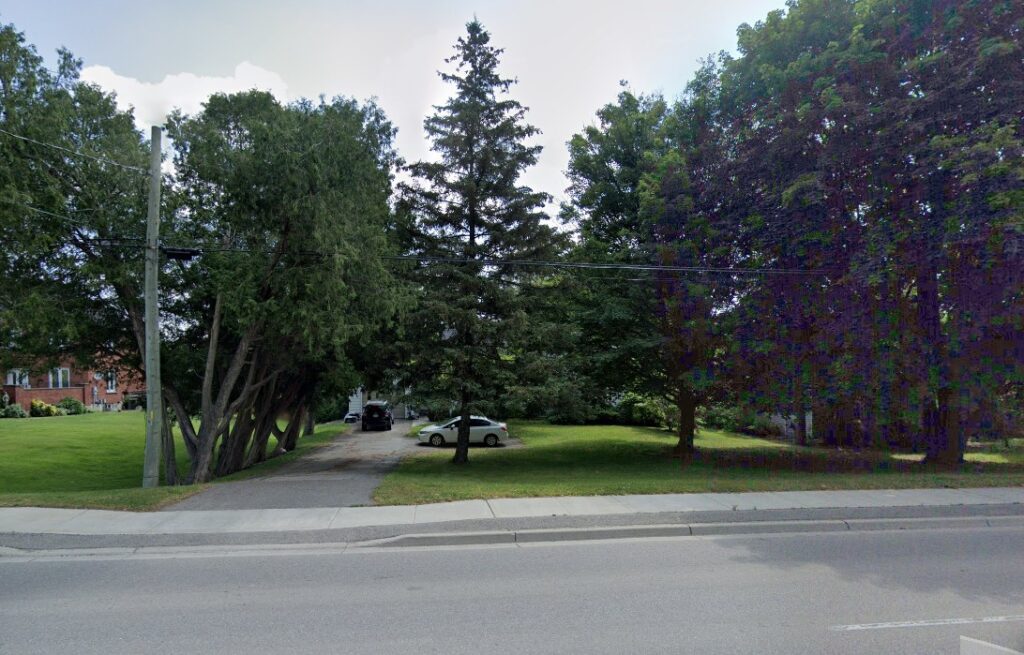 I have no other pictures of that house save those of its appearance and rooms that are stored in my mind’s eye. I imagine the road was single-lane then with sparse traffic although it was on the north edge of town and was actually highway 24. The long driveway brings back a recollection of our Grandpa Bruce making us wooden rifles, sling-shot equipped; we played in that lane-way, darting among the much smaller trees at the time, with those ‘weapons’ for hours thrilled that they were target-shooters. The exterior of the house was either yellow or light green; it was one story, long and narrow in structure. The front room faced west toward the street and was formal in its furniture including a piano in one corner. Rick took lessons, not by his choice if memory serves and at some point managed to convince his parents and teacher to shift from classical pieces to more modern music aligned to his comfort, taste, and ability/willingness to practice.
I have no other pictures of that house save those of its appearance and rooms that are stored in my mind’s eye. I imagine the road was single-lane then with sparse traffic although it was on the north edge of town and was actually highway 24. The long driveway brings back a recollection of our Grandpa Bruce making us wooden rifles, sling-shot equipped; we played in that lane-way, darting among the much smaller trees at the time, with those ‘weapons’ for hours thrilled that they were target-shooters. The exterior of the house was either yellow or light green; it was one story, long and narrow in structure. The front room faced west toward the street and was formal in its furniture including a piano in one corner. Rick took lessons, not by his choice if memory serves and at some point managed to convince his parents and teacher to shift from classical pieces to more modern music aligned to his comfort, taste, and ability/willingness to practice.
A wide archway opened to the kitchen, an inverted L-shaped room with a very large table – I remember all the cousins (7 of us, very likely the reason Aunt Betty watered down our skim milk) and parents sitting around that table – with the counter, sink, and shelves at right angles to the table and an exit door off that side of the kitchen. Immediately to the right of the living room exit was Rick’s bedroom, small but equipped with bunk beds (did I displace his younger brother Lorne when I visited?). I loved the top bunk which he granted me most of the time. We would sneak-read under our covers and talk in what we thought were low whispers always listening for the loud censure from Rick’s father. Roy contracted polio sometime in his twenties, I think. Walking was a struggle for him; he had to use a cane, maybe two, and his footfalls thumped when he swung his legs forward from the hips. The sound of his cane and the clump of his steps en route to chastise us was scary to me. Across the west edge of the kitchen, opposite Rick’s bedroom door was the main bathroom and just to its left, Rick’s parents’ bedroom. At the other east end of the long part of the L-kitchen was a larger bedroom, the girls’ bedroom occupied by Rick’s sisters, Dawn and Debbie and my sisters when we visited. At the back end of the house was a narrow ‘play’ room with cupboards filled with games, maybe a television though I’m not sure about that and possibly a smaller bathroom. At the very back of that room was the backdoor of the house. Of the games we played, this one remains indelibly imprinted on me:
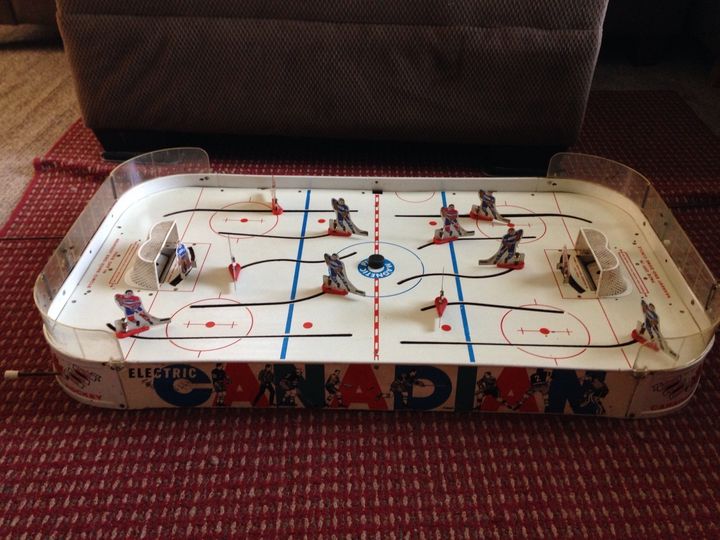
Though not the actual one we played, it is a solid replica; at each end of the playing ‘rink,’ 5 rubber end-capped rods moved your players, the 3 forwards and 2 defense men, up and down the visible grooves, while a flat, popsicle stick-shaped lever moved the goalie laterally in an arc across the net fronts. Moving players and the goalie lever required a learned and deft dexterity of hand-switching among the six levers for both offensive and defensive maneuvers. The puck was magnetic, the players tin and the teams were always the Canadiens vs the Leafs, two of the original 6-teams in the NHL of the 50s and early 60s. That game was mesmerizing; we played for hours. And I may be fabricating that the playroom had lots of toys but I do remember building ‘log cabins’ out of a toy-set and putting together Tinker Toys from a cardboard tube like this one:
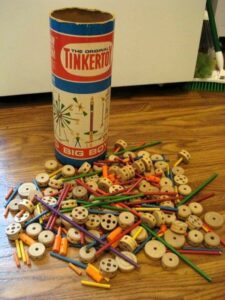
Outside the back door was a large garage in which Rick’s dad parked his yellow Chevrolet Bel Air, equipped with a hand-brake lever to the right of the steering wheel owing to his inability to move his legs to depress the brake pedal in customary fashion. Roy, to me, was an imposing figure, deep-voiced and demanding of proper (obedient, likely) childhood behaviour. At the same time, he instilled values in me and us with sayings like, “if a job is not worth doing well, it’s not worth doing at all.”I know Rick and I did chores, garden hoeing and weeding are the ones I remember. My Aunt Betty was one of the kindest, most affable human beings I have ever met; she was always radiant, smiling, supportive, and blessed with a silky smooth, high pitched speaking voice. I adored her.
However, the part of the Norfolk Street home’s backyard I cherish most is its winter portal to what I remember as Culver’s Pond, frozen over just for us. In drafting this blog, I tried to find the nearest small pond that would buttress my memories of that marvelous, natural hockey venue. The map below, a current screen shot, shows Rick’s house in red and the nearest small body of water about 500 meters away and Culver Lane some scant evidence that my pond nomenclature might even be accurate:
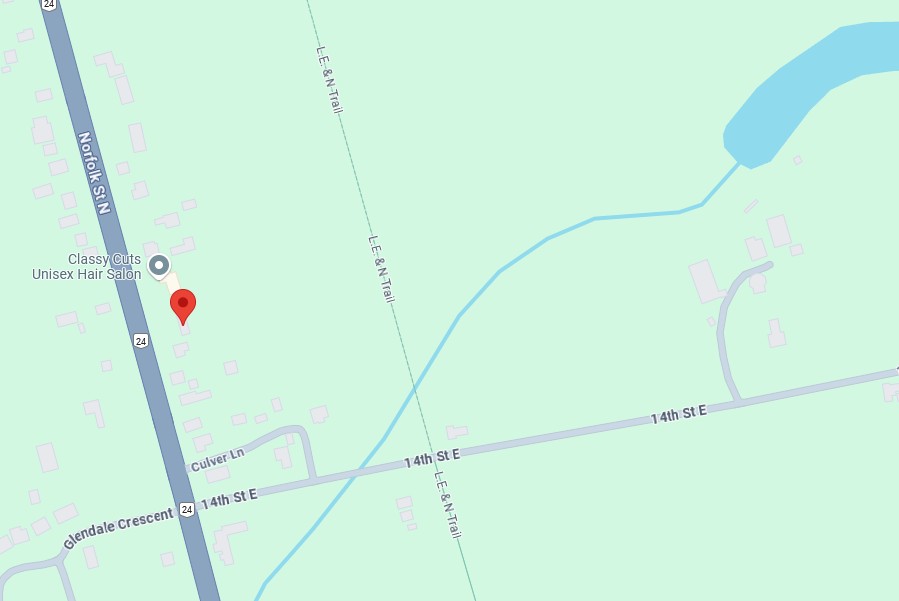
How we arranged games or knew when other kids would be there is beyond my recollection. It did seem like a long walk carrying, hockey sticks, pucks, and skates over snow-covered fields and through wooded areas but the rewards and allure image- and emotion-associated with playing hockey on the pond’s vast surface made the journey so worthwhile. We played shinny/hockey for hours and hours oblivious to time. Goal posts were likely boots, snow-banks the boundaries on one end and one side and who knows how we chose teams and did we bring shovels to clear the ice? I imagine now that our coats were doffed and any hockey sweaters proudly in abundance. It seemed like a vast expanse of rink and somehow skate blades dug in to the natural ice at least as well as on artificial ice.
The only outdoor ice cum hockey rink that rivaled Culver’s in my experience was that of the Bay of Quinte near Trenton, Ontario when Dad was stationed at the air force base there in the mid-1950s. Both ice surfaces proffered a seemingly limitless expanse of beckoning outdoor rinks. As I think on the Culver’s Pond locale now, could adults have reached us in an emergency? What if one of the kids were injured? Could they get to us from nearby 14th Street? Were they concerned about the thickness of the ice? Different times, I suppose. Did we come back for lunch? Did anyone keep track of time? For us boys, it was sheer joy of effort. We were as innocent as William Blake’s boys from charity schools entering St Paul’s cathedral their wardens (beadles) leading their Holy Thursday procession…
…their innocent faces clean,
The children walking two and two, in red and blue and green,
Grey headed beadles walk’d before, with wands as white as snow,
Till into the high dome of Paul’s they like Thames’ waters flow.
~ William Blake, Songs of Innocence, 1794
Our Thames/Culver’s was frozen; our reds and blues loyal to favourite NHL teams; our reverence sublime at our [St] Paul’s/pond-cathedral; and our freedom from wardens of any kind…pure youth, pure jollification…unfettered fun, fully and completely at play. The only other recreational activity I remember issuing from Rick’s Norfolk Street house was he and I fishing – well, catching small fish to see how many we could catch – from the stream under an overpass/bridge (?) just south of his house (likely the rivulet visible crossing Highway 24 in the map-image above).
Part and parcel of visiting Rick either at his Owen or Norfolk streets’ homes was staying at the farm, our grandparents’ farm located 7 miles west of Simcoe on the Turkey Point Road or Highway 10 (see one of my earliest blogs, woodcutter…the farm re the farm in general). The sheer magic of youth, it seemed then and seems now, happened at the farm, our farm. Rick and I, at 5 and 6 years of age are on the right of the woodcutter image below…
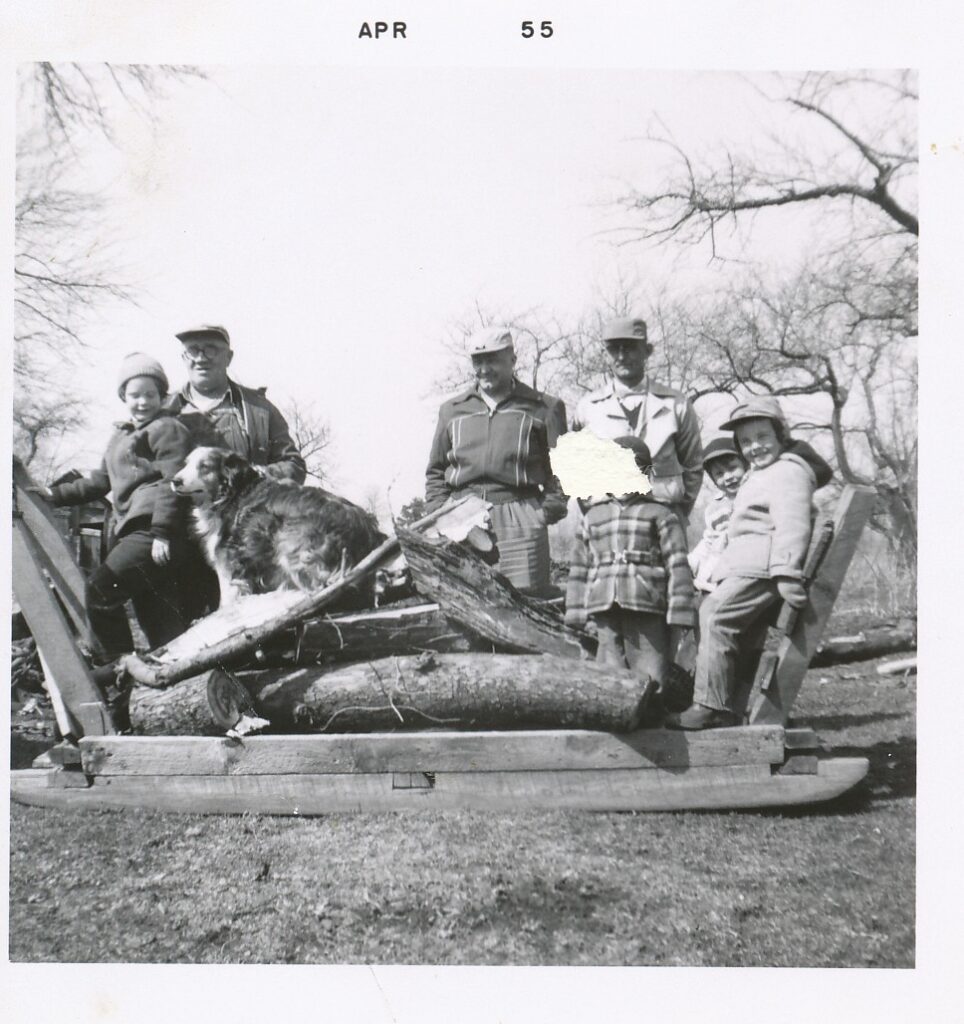
From right to left are me, Rick, his younger sister, Debbie (I think), Uncle Louis (my grandmother’s brother), my father (his posture and facial resemblance, chin-dimpled, to Louis is readily apparent and something I hadn’t noticed before), beloved Nipper the farm’s family dog, Grandpa Bruce, and Rick’s older sister, Dawn. Very likely, the wood-ladened sleigh was drawn by the horses I vaguely remember, Dolly and Queen.
It was the feeling of the farm that fed us, a feeling so underscored by Dylan Thomas’s lines from my favourite poem, Fern Hill:
And as I[we] was [were] green and carefree, famous among the barns
About the happy yard and singing as the farm was home,
In the sun that is young once only,
Time let me [us] play and be
Golden in the mercy of his means,
~ Dylan Thomas, Fern Hill, 1945
Quite simply, to Rick and me, the farm was our domain, literally our play-ground, the only boundary our imaginations. Inside, we played Cowboys – and probably Indians, innocently unaware of our discrimination – riding our couch arms’ as horses; watched 2-channel, antennae-fed TV when permitted; played fish with cards; sat with coverall-clad Grandpa Bruce (‘Stinky,’ we called him though I don’t know the reason) while he drank coffee and smoked his own hand-rolled cigarettes – I remember the packets of cigarette paper and Stinky licking the horizontal edge to seal the final product – on the screen porch, a multitude of corns on his fingers; ate sumptuously of home-make chicken noodle soup (real, home-made, flat noodles simmered in a chicken carcass broth) and in-season, bowls of strawberries and raspberries; loaded the wood box adjacent to the stove when asked; bathed in circular laundry tubs on Saturday nights; sought treasures in the rickety attic upstairs; laughed and languished in the double bed of the boys’ blue-striped wall-paper bedroom (when parents were there, we secretly listened in on adult conversations emanating from the living room below us though I remember not a single word of any conversation).
Outside the farm house were tantalizing, to us, buildings. There was the huge barn where Dolly and Queen were kept and the lure of the hayloft for hiding and jumping, wary of its corner holes. There was a cement water trough just north and west of the barn, the former furnished with a metal pump; perpetually, the grass and weeds usurped the height of the trough and huge spiders were denizens idly threatening us from their dense webs. Directly across from the house was the 2-car garage, each side sporting two horizontal wooden doors that swung open to the sides, the edifice itself replete with Grandpa’s tools – saws, hammers, accordion-folding measuring sticks, planes, anvils, and so many more tools. His truck, a black model T retrofitted with wooden tool boxes on the back, I think, occupied one side and a light green Plymouth sedan with side gear shift was on the other side. We could watch Stinky working on his garden windmill ornaments and occasionally he would let us hammer a nail or help paint the devices. At one time, there was a hen-house or chicken coop; I can remember us going to fetch eggs with Grandpa (we ‘harvested’ the chickens for meals). Later on, the hen-house was displaced by a second garage but I don’t remember what it contained. There was a large corn crib, not of much interest to us as kids. Hot summer days were cooled by sucking on ice-cube tray, Kool-Aid frozen cubes, each one cradled in waxed paper or delicately suspended from an embedded toothpick.
Some time in the 1950s, our grandparents sold most of the farm or perhaps rented a lot of the acreage to a neighbouring tobacco farmer. Grandpa either kept the wooded area or had an agreement to use it for a woodlot for the endless supply of wood needed for the kitchen stove. Two gardens framed the east (vegetable) and the south (floral) sides of the house. Perhaps we had to help hoe the gardens; very definitely, we got to ride with Grandpa aboard his Allis Chalmers’ tractor, something like this one…

It was orange with a metal seat and the curiously close two front wheels; it was started with a crank, the crank shaft visible just above the front wheels in the image. The steering wheel had a knob attached, presumably for ease in steering; for Rick and I, each seated on the back wheel guard on either side of Grandpa, we got to ‘steer’ by taking turns holding the knob while Grandpa tended the two large gardens. The motor was completely open and for some reason, I vividly remember being intrigued by the glass fuel-bulb that gauged the gas tank level.
At the front of the farm property was a huge tree to which was affixed the coveted swing clearly there to tempt Rick and me to see how high we could propel each other. Nearby was the huge – in horizontal length – metal driveway gate, rarely closed and always enticing us to ‘ride’ it by hanging from its latch or non-hinged end and taking turns pushing the rider. Closer to the back of the house were two small sheds, one, the two-seater outhouse dreaded for its perpetual smell, spiders, and lurking – in our imaginations – snakes; the other structure, located maybe 15-20 feet away was the ash-house, the repository for the stove ashes when we cleaned out the stove. My guess is the ashes were used for garden fertilizer, and for soap- and candle-making; my mother used to make decorative Christmas candles and I wonder now if she used the farm ashes. Across from the two sheds was the cistern well, a cement-covered hole in the ground used to collect ground- and rain-water. A long stretch of metal down-spouting, quite rusted, must have had a vertical pipe extended into the well and an angled portion extended at a 45 degree angle up toward the kitchen window and affixed somehow to one of the two hand-pumps inside the kitchen (that cistern-pump always had a glass of water beside it to be used to prime the pump). I’m pretty sure that wasn’t the water used for drinking; there was a second pump at the sink on the other side of the kitchen though I have no memory of its well source. Right next to the cistern well was the wood shed imaged, I believe behind my Mom and Dad who would be posed just behind the cistern well:
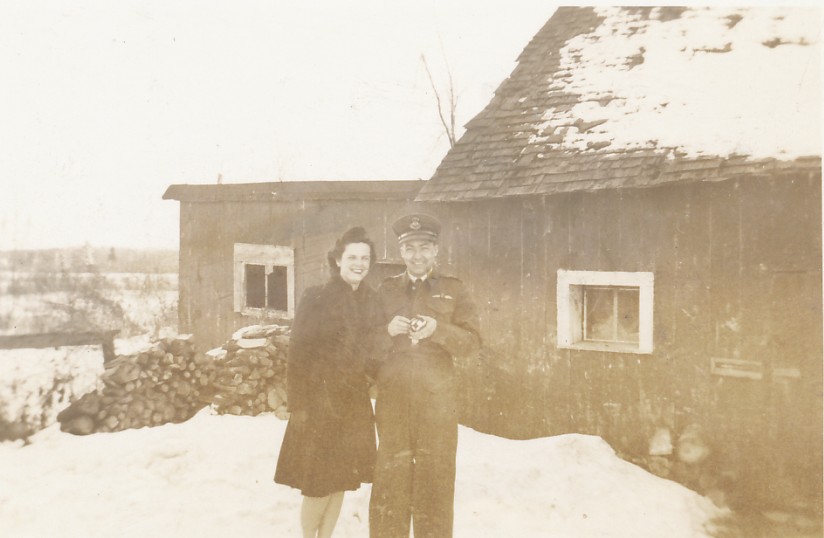
As an aside, their smiles are so full, something to do with an object in dad’s hand, at which he’s pointing, but I can’t determine what it was, a camera perhaps? If so, the camera would be very small for that era but it would befit my dad’s sense of humour to be taking a picture of someone taking their picture. At any rate, I just love how happy they were. How many arm-loads of wood did Rick and I carry from that shed to the wood box next to the stove? The end of the shed faced the eastern vegetable garden with a clothes line, maybe two affixed to the top of that wall. In this photo, my grandmother stands, perpetually apron-adorned, exactly as I picture her now:
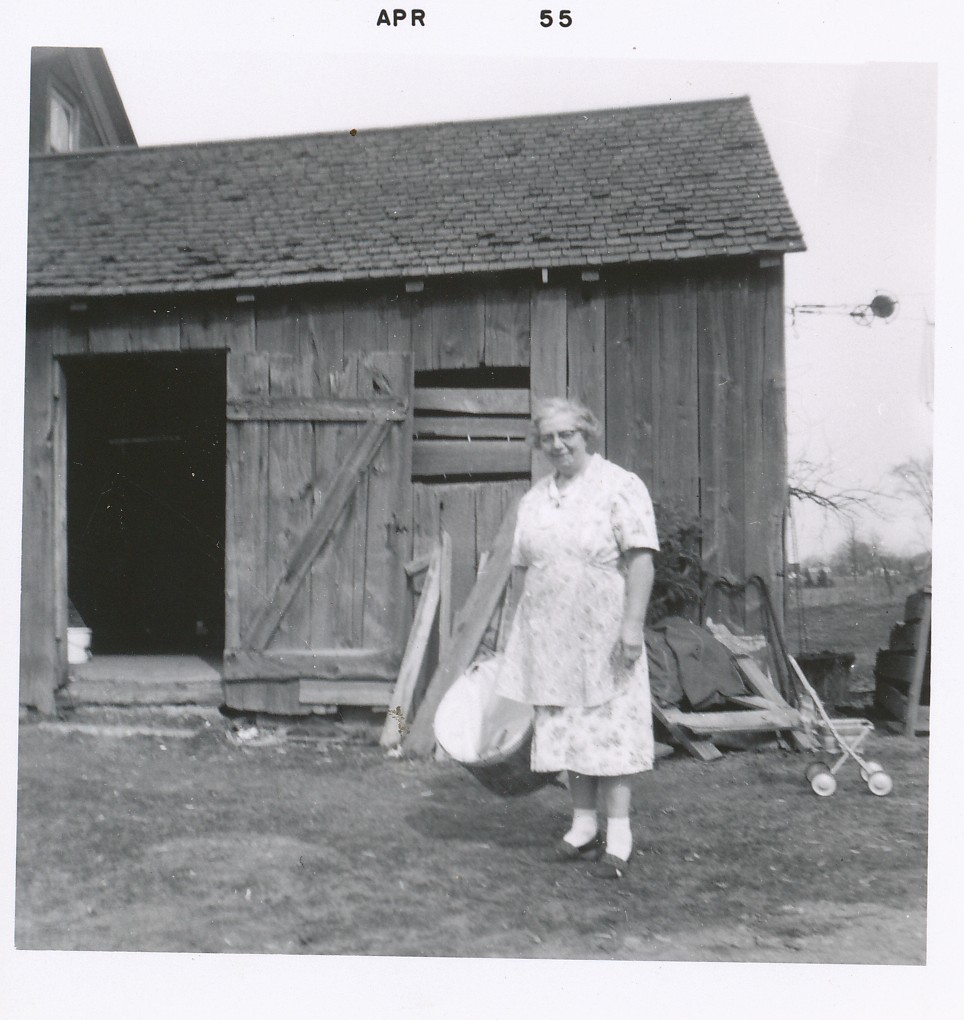
For Rick and I, the back of the shed was a special spot for us. With no indoor plumbing, we were encouraged to pee outside; a ‘thunder-pot,’ each one decorative porcelain, was located under every bed in the house and the rule was, you use it at night, you empty it in the morning. We very much preferred our favourite outdoor spot, this shed-wall and we made it a game to see who could pee the highest on that wall, literally then a pissing contest – boys will be….
Rick and I built forts out of logs and wood scraps and tents out of blankets. We never seemed to be bored or to run out of things to do on our farm. South of the floral garden, closer to the corn crib, we constructed our own high jump pit with wooden side-poles (likely built by/with our grandpa) and a bamboo pole for the bar. I’m guessing we used one of Stinky’s multi-hinged measuring sticks to record the height. Very definitely, our jump technique would have been the scissors’ style and the pit was sand likely ‘borrowed’ from the garden area. In retrospect, we must have spent weeks at the farm in the summers of our youth. Not many winter farm visits that I recall; more of those seasonal trips were to Rick’s homes in Simcoe. My dad must have been so committed to visiting his Mom and brother because it seems to me we traveled frequently from our homes in Trenton, Exeter, and London to Simcoe. The affinity Rick and I had was so palpable and easily reforged with each new visit. The farm was magic, likely our ‘happiest place on earth’ in our growing years.
To me, the most symbolic representation of our boyhood bond is captured in this image, circa 1955 or 1956:
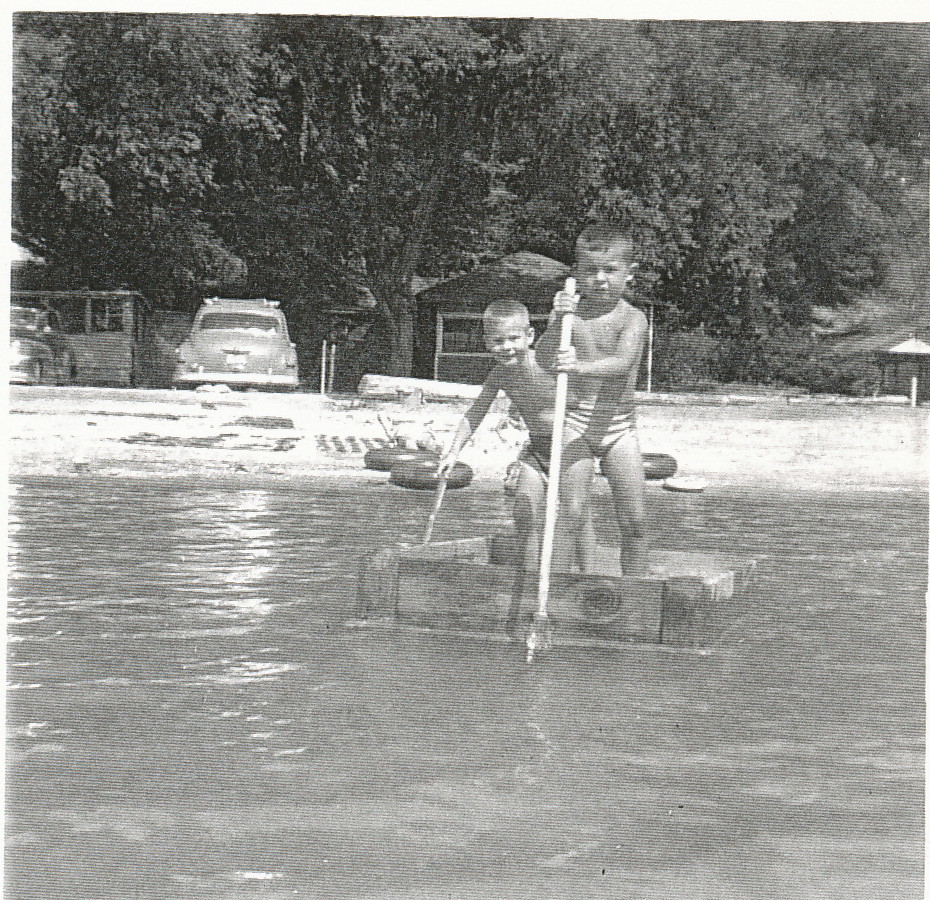
Our two families rented a (two?) cottage at Port Ryerse on Lake Erie, south of Simcoe and Port Dover. I have no memory of building this raft and only fragments of our time at this cottage. Our raft was an inverted box of some kind and Rick, radiant in his customary smile is in the stern whilst I am the facially stern poler at the front of our craft. Our body builds were different, Rick more ectomorphic and me more mesomorphic, likely the result of how we chose our parents. Somehow our haircuts are imprinted in my memory bank. So too the car and cottage on the left in the background seem familiar. I wonder now who took the photo? What is so compelling to me is that Rick and I built or converted this box into something we could do to propel our imaginations together inextricably connected, always doing something as a brace of boys exuberant in and committed to anything we could do together.
There were other cousins and other homes I visited in my youth – very different in feeling and experience from Rick’s homes or the farm and yet all parts of my boyhood raft of memories. One was this mansion at 46 Forest Hill Road, Toronto (2021 photo):
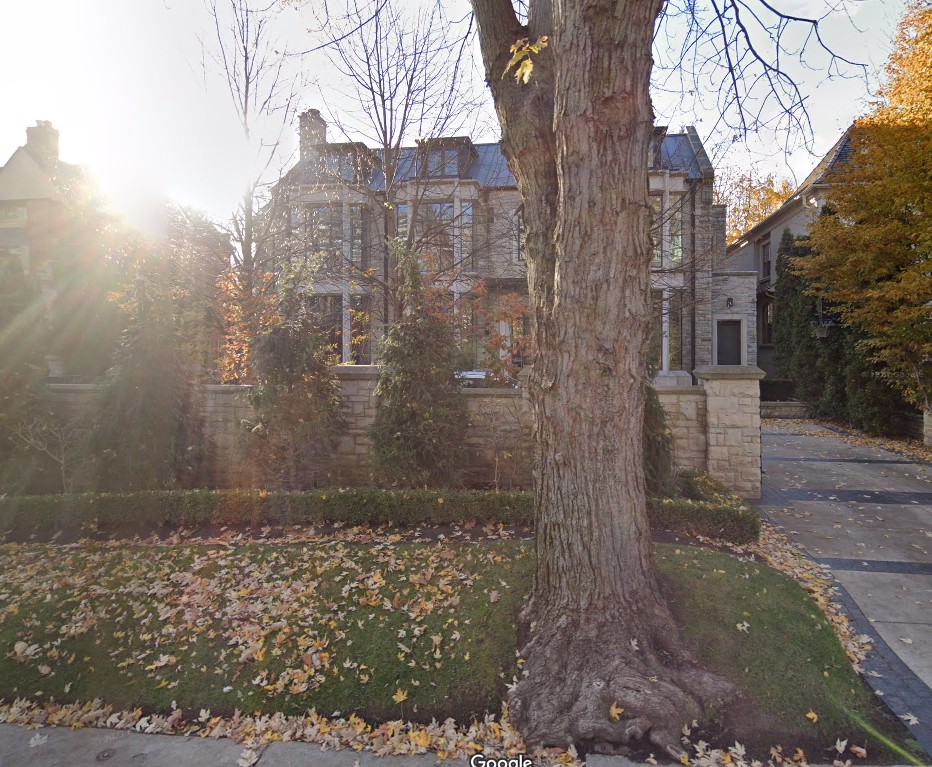
This is a current view of the home owned for years by my Uncle Jacob Markowitz and my Aunt Ruth (née, McCullough, my mother’s sister). If memory serves, the house – located not far from Upper Canada College – was purchased sometime in the late 1940s or early 1950s for something like $53,000. It sold, clearly modernized if adjudged by the roof and windows and grounds in the image above, in 1921 for $15 million. Quite simply, the house was huge. Uncle Marko (the name he preferred) was a remarkable man whom I remember as relatively short in stature (though I’m not sure how I believe that as fact) balding, perpetually clad in a muted, red-toned smoking jacket sporting a monocle and carrying a glass of wine as he welcomed us into his home. I cannot just mention his name in passing without acknowledging his professional prowess and his humanitarian contributions even though these are not directly relevant to my boyhood focus herein; however, who he was and what he achieved provides context for me and my memories.
Uncle Marko was a medical doctor with a PhD in Physiology. Born Jankel Marcovici 1901 in Bucharest, Romania, Marko was a Jew who experienced so much antisemitism during his lifetime (he died in 1969). The story of his remarkable medical exploits during the second world war can be read here in the Journal of Medical Biography as Transfusion on the Burma Railway: The Life of Jacob Markowitz, – a story for another blog perhaps, one that would be buttressed by referencing a wonderful memoir, Marko’s Story – 5 years in Marko’s life when he saved many hundreds of lives in prisoner-of-war camps in Siam (now Thailand) during World War II; it is lovingly penned as though in Marko’s first-person voice, by Aunt Ruth and I have a copy of her/his manuscript (about 250 pages) in my home. Ruth or Ruthie, as her sisters called her was soft spoken, articulate, and very erudite; I believe she served in the WRNS, the Women’s Royal Navy Service, popularly known as the WRENS, during the second World War. Of the many remembrances of Dr Markowitz’s professional contributions is this tribute captured in this image

It is of Dr Markowitz receiving the Member of the Order of the British Empire (MBE) from Viscount Alexander, June 1946; the profound respect for the newly appointed Governor General, himself a hero of the war, is clear from Marko’s countenance as is the dignity and respect he exudes at the honour. Marko wrote many research articles in prominent journals and authored one book, Textbook of Experimental Surgery, 1937; its usefulness in the field is documented by its review in the British Journal of Surgery (1938, copied here) and by the fact that the 528-page text with 330 illustrations went through 5 editions/revisions. A gold medalist when he graduated top of his medical class at the University of Toronto, it is clear Marko was intellectually gifted, and dare I quip, quite re-Marko-able.
As I noted above, I remember Uncle Marko always sporting his smoking jacket; his monocle hung from a lanyard of some kind around his neck. If he had occasion to mount it in his eye socket, he did so manually and then un-flexed the tiny eye muscles to let it drop unceremoniously to its resting spot on his chest. Marko’s domain when I knew him was the house itself. Dark wooden panels seemed to adorn many of its walls. The main floor had a large foyer, at least one large room to the left that I think was the living room. To the right was the dining room, very formal in decor and all meals were taken there and all food was prepared and served by a live-in maid/cook/housekeeper. Straight ahead was a door that led downstairs to Marko’s family medicine practice. On the wall adjacent to that door was a red light, perhaps a bell or buzzer system too. When patients arrived through a separate entrance and/or when Marko was in his office, the light was bright red. I was never invited to visit or see that office.
Thickly carpeted – red, maroon – stairs ascended to the second floor where the bedrooms and at least one bathroom were located. A third floor, readily apparent in the dormers atop the house image above, had one huge room – maybe others, I don’t remember – with a tiled floor and a bank of cupboard doors running the length of one side of the room. This was our playroom and my father once told me facetiously that Marko had a theory on child-rearing; let them play in a room all their own making sure the room had a central floor drain such that every once in a while the children could be hosed down, re-dressed, and then returned to their play activities. Thus, I have always associated this third floor room with that theory. Marko had a wry sense of humour exemplified by a clever prank he played on me. He owned a well-appointed black car, perhaps an Edsel, I’m not sure now. Driving somewhere with children in the back, I was seated beside one window. Suddenly, that window went down half-way. Accustomed to window crank-handles, I quickly figured out how to use the power button to raise it. A few minutes later, down went the window. I had no idea the driver, Marko, had controls for all of the windows and he demurely delighted – straight-faced and silent – in my bewilderment as we played some kind of window-tag.
Marko and Ruth’s children were Jane, two years older than me, and Thomas, born the same year as me. I had a life-long crush on Jane, she of dark hair, kind demeanor, and affable personality; sadly, Jane died in 2021. Cousin Thomas and I were certainly compatible and it was such a different relationship than that which I shared with Rick. Tom moved with a formality of motion – almost on tiptoe – and possessed a quiet chuckle. We didn’t visit his home often but I remember the immaculately groomed grounds and gardens; looking through Tom’s microscope at items he selected for our review (I believe he had a telescope in his room too); and for some reason at some point in time, we acquired small, bundled firecrackers and thrilled in setting them off and tossing them from his bedroom window or balcony. I remember Tom taking me on the streetcar to attend and partake of the rides at the Canadian National Exhibition sometime in the late 1950s and it was the streetcar ride that fascinated me, so much more than the exhibition (I never liked fair rides like roller coasters or other vertigo-inducing devices of torture).
In addition, I remember the formal meals in the dining room of that house. We were expected to dress nicely for dinner and to respect adult conversation and be mannerly. Wine was always served and I’m sure I was expected at least to try it. I enjoyed my infrequent visits to 46 Forest Hill Road and my cousins were always kind to me. The lifestyle was so different from that to which I was accustomed and my comfort was more aligned with my Simcoe ‘homes’ and to Rick, that affinity abetted, no doubt, from the amount of time I spent in those environs. Many years later, in 1973 or 1974, I needed to spend time in Toronto doing research on my doctoral dissertation at the Ontario Archives. Aunt Ruth invited me to stay at the house for quite a few weeks, made me lunches and other meals completely supportive of my research and my long walks along Avenue Road to and from the archives. The house seemed empty and yet Ruth filled it with her personality and kindness. And I got to eat in the kitchen, a room I had never seen as a child.
The only other boyhood home where I spent time with cousins was in Elmira, Ontario. My mother had 9 siblings, 6 sisters and 3 brothers. Just because I love the picture of Mom and her brothers and sisters, I am re-posting the very first picture from my very first blog (At Stake) written in 2018:
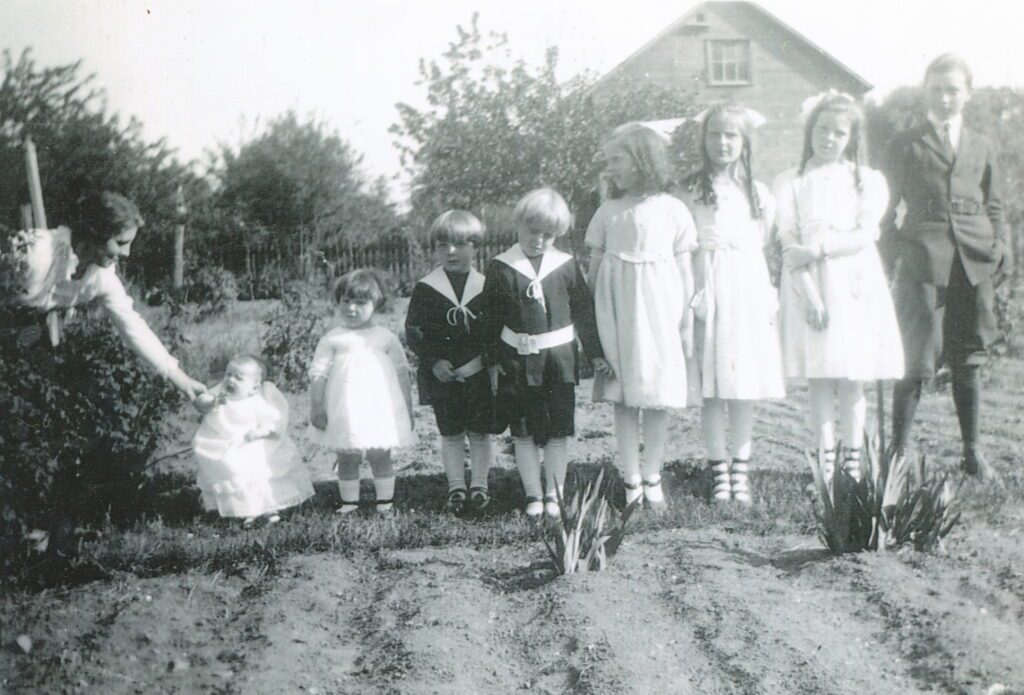
Mom is the smallest child, tied to a tomato stake, supported by my grandmother McCullough. Missing from this photo is Margaret, a child from my grandfather’s first marriage. It is the young man on the right, the eldest sibling, James Theodore McCullough (1907-1996) who is the cynosure of this part of my current blog (Ruth incidentally, is the young girl immediately to his right). Uncle Ted, like Marko, was a medical doctor. Here is a brief bio from his obituary in the Kitchener-Waterloo Record, 18 January 1996:
McCullough, Dr. J. T. (Ted) – Peacefully, on Wednesday, Jan. 17, 1996 at K-W Health Centre of Grand River Hospital, Dr. J. T. (Ted) McCullough, in his 89th year, of Elmira. Beloved husband of the late Reta (Galliher) McCullough who predeceased him March 19, 1991. Dear father of Margaret Jane McCullough of Ottawa, Robert J. of Mississauga and Thomas G. of Wilno, Ont. Fondly remembered by his eight grandchildren; brother of Ruth Markowitz of Toronto, Helen Rogers, Kathleen McCullough and Jean McCullough, all of London and Gordon McCullough of Brome, Que. Predeceased by two sisters, Margaret and Marion and one brother, Ronald.
A graduate of the University of Western Ontario Medical School in 1930, he entered into general practice in Alma, Ont. with his uncle James and George McQuibban. The practice was subsequently moved to Elmira in 1933 where he continued to practice until his retirement in 1977. His long association with both St. Mary’s and the K-W Hospitals was recognized by a term as president of the K-W Medical Society. A strong advocate of the specialty of family medicine, he was an influential member of the Canadian College of Family Physicians serving as president in 1963 and 1964. As well as representing Canada in the World College, he was an honorary fellow of the American and Australian Colleges of General Practice. A faithful member of Gale Presbyterian Church, Elmira, he was recently recognized for having served 50 years as church elder. Dr. McCullough will be missed by many colleagues, friends, family, patients and his associates in the community.
Ted and Reta owned a home on what seemed to me a sprawling acreage just on the outskirts of Elmira, a small town about 23 km north of Kitchener. I believe the home was adjacent to Highway 85, the main road coming into the town. I don’t have any pictures of the house, nor can I find the address to see if it’s still there. I remember it as red brick with a huge garage and an outdoor barbecue bricked oven, something that was rare at the time. Uncle Ted, mustachioed, tall and dignified in his bearing always seemed to have a cigar or cigar butt in one hand, his other hand in his pocket just like he posed – hands-in-pocket – in his youth above. I did not and do not know much about his family medicine practice although I am so impressed by his professional accolades described in his obit above; I believe his office was in town rather than in his home. And I feel some latent affinity to Ted in that we share the same alma mater (Western, graduating a mere 41 years apart) and my pIace of employment for more than 4 decades. I do have recollections as an adult that Ted and Marko worked together and did their professional best to be of help when my mother was sick and dying in Kingston hospital circa 1956-7.
We did not go to Elmira very often; mostly at Christmas or other winter holiday times, I think. My cousin Tom and I were closest in age among the Elmira cousins so we played together during those visits. Tom was kind and quiet, likely introverted and we did seem to get along quite well. We played hockey at backyard rinks in his neighbourhood. Margaret and Bob, his siblings were older than me; Bob was effervescent in personality always in motion, always doing something, and Margaret, elegant, poised, and articulate. I do not remember the interior of the Elmira-McCullough house very much at all. I believe there was a large family room in the ‘basement’ or downstairs’ area. My most vivid memory of my time/s in that house is an olfactory-inspired one. Tom, Bob, and I slept in twin-sized beds upstairs somewhere near a railing that I assume was adjacent to the stairs. Aunt Reta was a very sweet woman and always wore a bun in the back of her hair. At Christmas time, she made a delightful candy, Russian toffee and I am embedding the recipe Russian Toffee just for the fun of doing so. It was a hard candy, very tasty, like no other flavour I know. The ingredients had to be cooked and stirred constantly for more than 30 minutes; at some point during the candy-formation, perhaps at its hard crack stage, the mixture smelled like vomit and it is that smell that I always associate with my Elmira memories.
My mother’s family, the McCulloughs were close-knit and for years, one/some of them would take the initiative and organize a family reunion. Below is a photo of all the cousins at one such reunion in the late 1990s:

In the photo, I am near the back-centre, flanked in the row behind me, on my right by Elmira Tom (bearded) and on my left in the same back row by Thomas Markowitz. Thomas’ sister Jane is in the black sweater in the very center. My sister Marnie is in the pink dress and Sandi, my older sister, is at the very front hugged by Elmira Bob. If pressed, I can’t name many of the other cousins; note we wore name tags likely for the very fact that while we all knew our aunts and uncles, we did not see many of the cousins as adults all that often.
Elmira, Toronto (46 Forest Hill Road), and Simcoe and their respective homes and cousins were all rich parts of my boyhood. And still it is my inextricable connection to and with Rick that rebounds so prominently from my memory bank, almost phantasmagorical, a dream kaleidoscope of cached remembrances. In our teens, Rick and I spent less time together. We both worked in tobacco (see my blog, Hanging Kiln) in the summers of the early to mid 1960s, but always on separate farms. I assume that was for ease of daily transportation with Rick working closer to his house. I worked first for my Uncle Lloyd Hall (and my Aunt Twila) at his new farm with my cousin Brad Hall the summer after grade 8; Gram and I boarded at that farm and Gram ‘handed leaves’ while I hung kiln, terrified of climbing the rafters carrying sticks of tobacco leaves, during that summer’s tobacco harvest. Rick and I spent some time with Brad at Gram’s farm; tragically, Brad was killed in a motorcycle accident in his late teens or early twenties. It was on Uncle Lloyd’s farm where at 12 years of age I first drove a car; Brad and I were allowed to drive an old, green Ford station wagon around the farm fields.
For the next 3 summers, from early August to early- to mid-September, I stayed at Gram’s farm and worked at the farm of Roger and Laura Clarysse, the people who bought or rented the farm-land around my grandparents’ home. Stinky died in the early 1960s and Gram continued to work in tobacco harvests but not near her farm and so boarded where she worked. That meant I lived alone on the farm, a tremendous responsibility for a young man in his early- to mid-teens as I think about it now. Tobacco work was exhausting so there wasn’t much I could do to get into trouble and I was in the country. Having learned to drive tractors with their clutch- and gear-systems, at 15, I once drove Gram’s Plymouth up to and back from the cold storage store along the Turkey Point highway, about a mile or two south of the farm. I had to get a special farm driving license to drive boats of tobacco along that highway between Gram’s place and the main Clarysse farm about 3 km away. And Roger let me commute by driving the tractor back to Gram’s at the end of each work day; I parked it under the roof of the corn crib.
In the summer after grade 12, Gram had sold her house and moved to an upper apartment of a house in the southwest part of Simcoe; I stayed there and commuted to and from the Clarysse farm on my Yamaha 80 motorcycle. A few times, Rick and I would go for rides on our motorcycles, but not far…my top-end was 50 miles per hour. And we were both tired from our 7-day work week with days starting at 7:00 am; plus, I had a girlfriend, Roger’s daughter – yes, literally the farmer’s daughter – Maureen and tended to spend my free time with her. in the Summer of 1967, Uncle Roy managed to get Rick and me jobs working in the Simcoe factory of Canadian Coupling and Fitting where Roy was employed as an accountant. Gram was having health issues and had moved to a small apartment in Talbot Street in Simcoe; Roy and my father thought it would be easier on her if I roomed elsewhere and I did so at a boarding house a few blocks from her and not far from Simcoe’s famed Carillon Tower. Our jobs were piece work – see my summer jobs blog Berries, Pins, & Copper Tees – wherein Rick had the more back-bending and tedious job on one of the tap machines that required constant manoeuvring of 7 vertical taps or boring devices all cooled by constantly fed oil feeds on each tap. We hung out occasionally, usually having a meal or tea with Gram but it was our last time of consistent connection in our lives. We didn’t, to the best of my recollection, talk about our boyhood; we just kind of accepted it as a given of our coupled pasts.
Pretty much we went our separate ways after that summer, me to university and Rick very likely to his clothing store and then truck-driving careers. Frequently in the Fall for many years, I went to Simcoe to pick McIntosh and Spy apples, usually at some farm Rick recommended and if at-home, he would meet me for coffee. Once, curious about what the farm property looked like now, Rick warned me not to go look; he said it was run-down and would be better left in my memory. He was right. The house was dilapidated and the property had not been maintained. I choose to remember it as we knew it in our boyhood days. Occasionally, he accompanied me to visit my parents’ graves at Simcoe’s Oakwood Cemetery. And Rick came to both my weddings, always literally and figuratively in good spirits…

This is Rick, beer-in-hand, toasting Jen and me from the top our backyard at our wedding speeches, 21 June 2003. That image is how I choose to remember the adult version of my best boyhood friend. In some ways, there is a fittingness to Rick’s death date, January 8th, two days before my dad’s birth date; I often felt my dad and Rick were so much alike in behaviours. They were both adventuresome; loved big engines (planes for my dad, trucks and big bikes for Rick); they both sold clothing early in their adult lives and both had salesman personalities; both loved Louis L’Amour western novels; and they even had similar-sounding chuckles. So too were there similarities between his father, Roy and me – organized, serious, athletic, value-oriented. I don’t know very much at all about Rick’s adult personality (some of his interests extracted from social media were highlighted earlier in this blog) except that he was always kind to me, affable, I believe to everyone, comfortable in his Simcoe and professional driving domains – I suspect he could ‘shoot the shit’ with anyone – a smiling sovereign of his Richard-Rick realms. As his son Sean said about his dad when I sent my condolences to him in January, “he was a good soul that meant well but had his opinions for sure.” Rick navigated his life in the best way he knew how to do so, just as he navigated his rig, and just as he sterned/navigated our raft. If he did have dyslexia and/or was on the spectrum, it seems clear he did not let those issues define him in his adult life. In our youth, he and I created play from our self/selves, from each other, from everything to which we had access, and sometimes, from nothing but pure childhood imagination. As for me, I choke up, teary-eyed now as I re-image and try to re-experience Rick and me poling that raft – buoyant and boy-ant – at Port Ryerse. I tumble home to our boyhood and to the treasured times, the ‘raft’ of memories we created and I spent with Rick Morrow.
~
Aftermath
Writing or more accurately, finishing this blog, while delightful to create, was hard. I loved and I grieve Rick and this was a great way to engage in and with that grieving process. Time to let him go. I am reminded of the lines in the Sarah McLachlan pop-rock song, “I will remember you:”
I will remember you
Will you remember me?
Don’t let your life pass you by
Weep not for the memories
I rejoice in and weep for the memories and I will remember you. Ave, Rick, go in peace…
